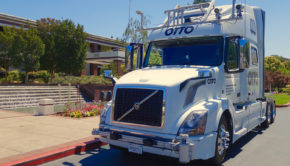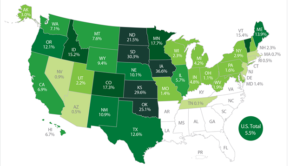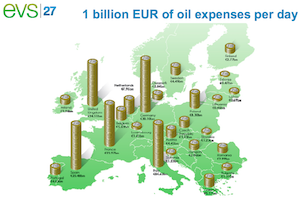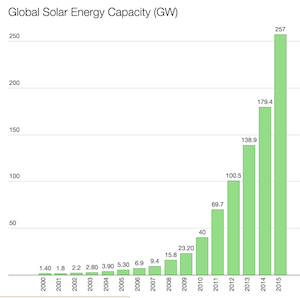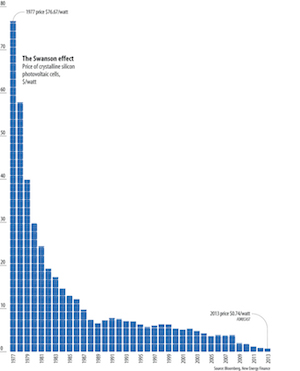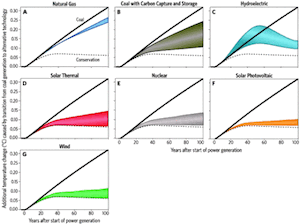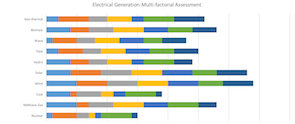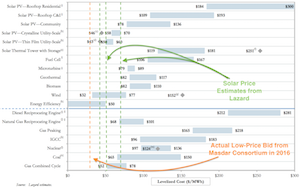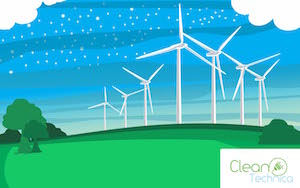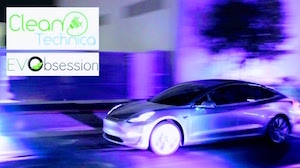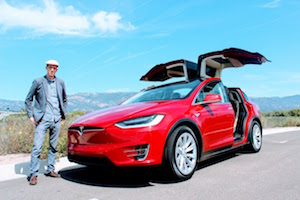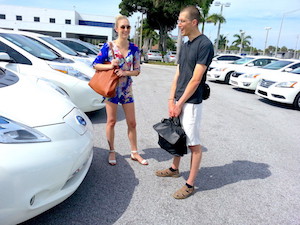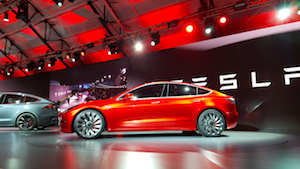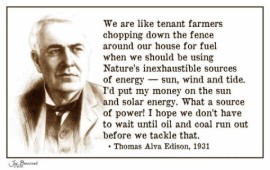Cost of Wind Power — Kicks Coal’s Butt, Better than Natural Gas (& Could Power Your EV for $0.70/gallon)
May 1st, 2011 by Zachary Shahan
This is part of an ongoing project to create a comprehensive resource page on all things wind. Chime in if you’d like to contribute by dropping a comment below. Or send me a message on Twitter @zshahan3 or Facebook.
What’s the cost of wind power? Well, of course, it depends on where you are and who you ask. But I’m going to do my best here to share some reliable information and put it in a useful context for you. Overall, wind costs have dropped significantly in recent years, and while wind is at least cost-competitive with coal and natural gas these days, looking at its true costs indicates it is much cheaper.
How to Measure Cost
There are a few different ways you can measure electricity cost. For example:
- Levelized Cost of Electricity (LCOE) — the utility way (the average cost over the lifespan of the project, initial investments plus operation and maintenance costs, not including externalities).
- Wholesale price — hard to get complete numbers on this; many sources will not divulge them.
- “All In” — taking into account externalities — health/environmental costs (yes, these are real costs that we pay that, of course, vary according to the energy source).
The figures you normally see and which are provided in most cases below are according to #1, LCOE, which artificially makes the cost of coal and gas cheaper than it should be. But don’t worry, I get into #3 a bit as well.
Now, a lot of people may bring in the issue of subsidies here. Taking subsidies into account, wind would fair even better, as total historical subsidies and current subsidies heavily favor fossil fuels. For more on this matter, check out this video of AWEA CEO Denise Bode taking on FOX News.
Wind Costs Compared to Coal & Natural Gas
The American Wind Energy Association (AWEA) announced at the beginning of the year that wind power was cost-competitive with natural gas in the United States.
“Wind’s costs have dropped over the past two years, with power purchase agreements being signed in the range of 5 to 6 cents per kilowatt-hour recently.” Elizabeth Salerno, AWEA Director of Industry Data & Analysis, said. “With uncertainty around natural gas and power prices as the economy recovers, wind’s long-term price stability is even more valued. We expect that utilities will move to lock in more wind contracts, given the cost-competitive nature of wind in today’s market.”
More recently, AWEA told investors at a wind finance workshop the same thing as well as the fact that wind is now beating coal in this category and a little more on why and what’s expected in the near future (generally).
AWEA figures show that the average wind PPAs are now being priced at about 6 cents per kilowatt-hour, the same price for energy procurements from a combined cycle natural gas plant. The group says wind is actually about 2 cents cheaper than coal-fired electricity, and more projects were financed through debt arrangements than tax equity structures last year, a possible sign that wind deals are winning more mainstream acceptance from Wall Street’s banks….
[AWEA chief economist Elizabeth] Salerno credits the breakthrough in cost to improved turbine design and performance, higher towers and longer blades, which have boosted the reliability and performance of wind power generation. Equipment makers can also deliver products in the same year that they are ordered instead of waiting up to three years as was the case in previous cycles, she said, calling it a sign of a mature supply chain.
The group estimates that 5,600 MW of new installed capacity is under construction in the United States, more than double the number at this point in 2010. Thirty-five percent of all new power generation built in the United States since 2005 has come from wind, more than new gas and coal plants combined, as power providers are increasingly enticed to wind as a convenient hedge against unpredictable commodity price moves, AWEA said.
While the above statements concern wind power in the U.S. (the lowest-priced wind power market), the trend is the same worldwide.
Wind Power Costs, Prices Dropping Worldwide
“Prices have dipped below €1m per MW for the first time since 2005, according to the latest edition of Bloomberg New Energy Finance’s Wind Turbine Price Index,” Bloomberg New Energy Finance wrote in February, 2011. For us Americans, that translates to about $1.48 million per MW.
“The cost of electricity generated from wind is now at record lows: several projects in high resource areas (US, Brazil, Sweden, Mexico) display a levelised cost of energy – excluding the impact of subsidies but after including the cost of capital and maintenance – below EUR 50/MWh ($68/MWh). This compares to current estimated average costs of $67 per MWh for coal-fired power and $56 per MWh for gas-fired power.” (In $/kWh, the figures would thus be less than $0.068/kWh for wind, $0.067/kWh for coal, and $0.056/kWh for gas-fired power.)
Important Note: While LCOE is widely used to compare various sources of energy, even not including the fact that it doesn’t account for health or environmental costs, it has its weaknesses. For example, LCOE for wind projects are often based on a 20-year lifetimes for wind turbines.
The oldest installed commercial wind turbines in the world, at Altamont Pass in California, were just replaced (or are in the process of being replaced) after 30 years of operation and the reason for it is a legal suit regarding endangered bird deaths — NextEra Energy Resources LLC, the company that owns the project, is replacing them with much more efficient turbines in order to reduce the number of turbines significantly.
The Department of Energy, which seems to use this 30-year assumption, found the price of electricity from new wind farm plants ranged from 4 to 9 cents per kilowatt-hour in 2009, which is competitive with other new power plants and essentially the same as AWEA reported above. However, if a 30- or 40-year lifespan were used for the projects, the costs would be much lower, as the huge majority of a wind project’s costs are from the initial investment (wind, the ‘fuel’, is free and there are minimal operating and maintenance costs).
Wind is MUCH Cheaper than Coal & Natural Gas (if You Know How to Add)
Now, as I hinted at the top, if you take the full health costs and environmental costs of various energy sources into account, wind comes out looking even better. A recent study out of Harvard found that if one adds in the hidden costs of coal then its actual price in the U.S. is more like 9-27 cents higher per kilowatt hour. The authors write:
Our comprehensive review finds that the best estimate for the total economically quantifiable costs, based on a conservative weighting of many of the study findings, amount to some $345.3 billion, adding close to 17.8¢/kWh of electricity generated from coal. The low estimate is $175 billion, or over 9¢/kWh, while the true monetizable costs could be as much as the upper bounds of $523.3 billion, adding close to 26.89¢/kWh. These and the more difficult to quantify externalities are borne by the general public.
This makes the true, “all-in” cost of coal electricity somewhere between 17 cents and 35 cents per kWh. You pay 8 cents or so per kWh on your electricity bill and then quite a bit more than that in healthcare costs, health insurance premiums, and with your tax dollars. Wind? It’s sticking to its original 4 to 9 cents per kWh.
As far as natural gas, I’m not aware of anyone doing a full cost accounting of it, or even counting in the health costs. It may not be as bad as coal when it comes to global warming emissions (though, some argue that), but it definitely emits more than wind. Additionally, water quality problems are a huge issue with natural gas, and since we are just discovering this (or it is just coming out into the open and the mainstream), I’m sure quantifying those costs is a huge task. However, again, you can be sure that there are significant costs and that there’s not the same issue with wind power.
Cost of Powering Our Cars with Wind
This is an interesting side note I thought I’d add. According to AWEA, based on the current cost of wind expressed in above sections, powering your electric vehicle with wind power would be several times cheaper than fueling up with gas now. “By powering our electric cars using wind, Americans can pay the equivalent of 70 cents a gallon at the pump,” AWEA stated. Interesting.
I don’t know how AWEA came to that conclusion — haven’t seen the calculations. If you have more info on this or want to try your hand at doing your own calculations, feel free to and shoot us your findings!
Google: Wind is Just a Good Investment, Cheap
While Google is known for its enthusiasm for clean, renewable energy now, something not often mentioned is that it is not only a clean energy leader because of its altruistic tendencies, but also because it just makes good financial sense. Catch this recent admission from one of Google’s higher-ups:
One of the main incentives for Google is financial returns. Rick Needham, Google’s green business operations manager, told me last year the North Dakota wind farms were an attractive deal for Google on the basis of the returns alone.
Wind power purchase agreements (wind is the cheapest utility-scale clean power out there) can set wind power rates around six cents a kilowatt hour for a 20-year contract, depending on location. It can sometimes cost even less with federal subsidies. As Lux Research analyst Ted Sullivan told me in an interview last year, “That’s pretty cheap.”
More sophisticated information on wind power costs, how it is driving the price of electricity down, and a look into my crystal ball to talk about the future are coming in my next article. Keep your eye out for it.
Related Stories:
- World Wind Power
- Offshore Wind Energy Cheaper than Nuclear Energy, EU Climate Chief Says
- Installed Wind Power Capacity per Capita (Country Comparisons)
Image via clarkmaxwell
Buy a cool T-shirt or mug in the CleanTechnica store!
Keep up to date with all the hottest cleantech news by subscribing to our (free) cleantech daily newsletter or weekly newsletter, or keep an eye on sector-specific news by getting our (also free) solar energy newsletter, electric vehicle newsletter, or wind energy newsletter.

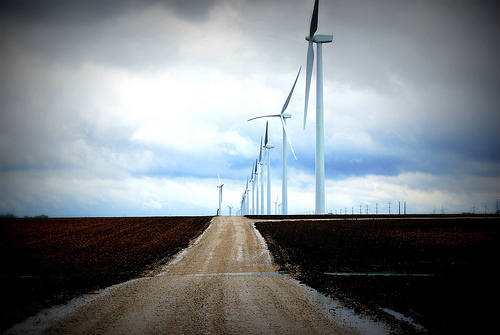
.jpg)
